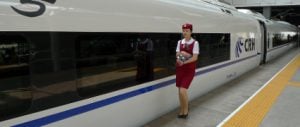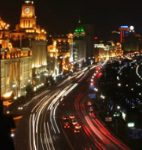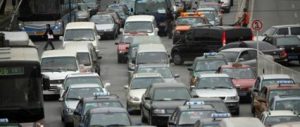On the evening of July 23, at least 40 people were killed when two trains collided near Wenzhou, on the high-speed line that runs down China’s eastern coast between Beijing and Shanghai.
Many railway signalling experts found the news impossible to believe: both the railway line and the trains that run along it use mature European technology. The drivers could fall asleep and a collision would still be impossible – at least, that’s what they thought.
Even harder to comprehend was the aftermath: the wrecked train carriages, which could have been examined as part of the investigation, were broken up by excavators and removed from the scene less than 48 hours after the accident. Two days later, trains were again passing along this section of track but, except for damage to barriers on the bridge, there was little sign of the tragedy.
Prior to the accident, China’s high-speed rail sector had been attempting feats that even pioneers of the technology, such as Japan and Germany, hadn’t dared to undertake – particularly in terms of speed.
Liu Zhijun, the former railways minister known to industry insiders as “Mad Liu” and since dismissed from his position for “serious breaches of discipline”, had demanded that frontline staff continually to increase trial speeds. On December 3 last year, for example, the new generation CRH380AL Harmony train – which can reach a maximum speed of 486.1 kilometres an hour – was being tested on the Zaozhuang to Bangbu stretch of the Beijing-Shanghai high-speed line. Liu was in the cab for the trip and is said to have ordered the driver to reach and maintain the maximum speed, to the terror of a foreign engineer present, who pleaded with them to slow down.
“There’s no question that in the next five to 10 years, China’s high speed trains will be running at speeds of over 400 kilometres per hour,” said Zhang Shuguang, formerly deputy chief engineer at the Ministry of Railways, and one of Liu’s favourites. “And in the next 20 years, we may break 500 kilometres an hour.”
Zhang even described the “magical” feeling of high-speed train travel. Ride a train moving at 350 kilometres an hour and imagine the carriage isn’t there – you’re flying at one hundred metres a second, sitting one and a half metres up in the air.”
In the last eight years, Liu Zhijun – a stalwart proponent of “leapfrog development’”– has overseen construction of 18,000 kilometres of railway tracks, 8,358 kilometres of which are high-speed lines now in operation. Some 30,000 kilometres of track are under construction or in planning, including another 13,000 kilometres for high-speed travel. During the 11th Five Year Plan (2006 to 2010) investment in railway infrastructure nationwide reached 1.98 trillion yuan (US$307.7 billion), 6.3 times the outlay of the previous five years. If it hadn’t been for recent adjustments to the plans, 850 billion yuan (US$132 billion) would have been spent on high-speed rail construction in 2011.
Liu publicly said many times that China could boast “the most comprehensive high-speed rail technology, the best ability to integrate those systems, the longest railway network, the fastest operating speeds and the largest scale construction plans in the world”: China had become the leader in high-speed rail development.
Incredibly, within six minutes of trials starting on the new Beijing-Shanghai line, trains had reached speeds of 302 kilometres an hour. This shocked Kato Yoshikazu, a consultant from Peking University’s Japanese Association, long-time Beijing resident and public commentator: “It took Japan 50 years to get from 200 to 300 kilometres an hour,” he said. “In China, it took five.”
China started developing its own electric trains in 1998. Test speeds started at 200 kilometres per hour and steadily climbed. On November 27, 2002, The DJJ2 model made headlines when it reached 321.5 kilometres per hour.
But regrettably China’s own trains were squeezed out of the market just as commercial viability was within reach. At the end of 2006, Jin Luzhong, former head of the Technical Cadre Bureau at the State Science and Technology Commission and researcher at the Ministry of Science and Technology’s research centre, made a formal complaint about this. Five years later, he recalls what he wrote: “The results of indigenous research are on the cusp of commercial viability, but due to the actions of current leaders at the Ministry of Railways [read: Liu Zhijun] indigenous innovation has been blocked, the future of “422” is uncertain and major technological achievements are at risk of being lost.” Jin asked that further imports of high-speed carriages and locomotives be halted.
The “422” mentioned here refers to a set of trains successfully manufactured by Chinese railway institutes between 1999 and 2003: the four Blue Arrow, Vanguard, China Star and Changbaishan high-speed trains; the two Aomi and Tiansuo high-speed electric locomotives; and the two Western Light and DF8CJ diesel locomotives.
Jin explains that, at the time, eight Blue Arrow high-speed trains had already been running between Guangzhou and Shenzhen in south China for years – the technology was mature. Four more trains were ordered for the Dalian to Shenyang line in the north-east, a move the previous Ministry of Railways leaders approved and made the initial payment for. But in 2003, with no explanation, the ministry halted the purchase, resulting in tens of millions of yuan of components being abandoned in warehouses, where they remain today. Other “422” projects were similarly rejected, attacked or cancelled.
Why were domestic high-speed trains rejected in favour of foreign models? Liu was “eager to achieve high speed passenger travel on several major routes as soon as possible in order to create a sensation.” Liu was removed from his post in early 2011, suspected of major breaches of discipline.
Once Chinese trains such as China Star were mothballed, Liu had looked to technological cooperation with manufacturers in Japan, Germany, France and Canada – aiming to swap “technology for market” and accelerate development of high-speed rail. As part of efforts to “import advanced technology, jointly design and manufacture and create Chinese brands” in 2004 the Ministry of Railways imported the world’s most advanced 200-kilometre per hour, distributed-traction, high-power electric, and diesel technology. Three years later, Liu successfully led the railway network’s sixth speed increase. “With one fell swoop, China’s high-speed rail network has leaped into the world’s most advanced ranks.”
The day that speeds were increased, Liu announced that “after absorbing technology and further innovation, Chinese firms have mastered nine core and auxiliary technologies for trains and high-power locomotives. Seventy percent of components in these Chinese-brand trains and locomotives are produced in China.”
Despite controversy, Liu was intent on pushing his grand plans ahead, seemingly at any price. As the global economy collapsed in 2008, the Chinese government gave 1.5 trillion yuan (US$233 billion) of its 4 trillion yuan (US$622 billion) stimulus package to the Ministry of Railways. Over the next three years, the ministry invested over 700 billion yuan (US$109 billion) in the sector annually.
The results of this investment can be seen everywhere. Railway construction projects abound in China, costing hundreds of billions of yuan every year. The possibilities for profits through that spending are clear, and a complex web of interests has arisen as a result. Many individuals are profiting from high-speed rail. According to a report by 21st Century Business Herald, senior executives in some 10 listed firms involved in the supply of power, communications, signaling, monitoring, locomotive and carriage systems are part of the Ministry of Railways clique.
Liu wanted as soon as possible to achieve his dream of “flight on the ground” for all weathers. His team told the media on more than one occasion: “Chinese high-speed trains will not collide.” The day the Wuhan to Guangzhou line opened, with an average speed of 273 kilometres per hour, ministry spokesperson Wang Yongping again stressed that China’s high speed railways are “world leaders in comfort, safety and speed”.
This also led the railway authorities to believe high-speed rail could continue to grow at breakneck pace.
You can see this in China’s medium- and long-term plans for the rail network. By 2020, China is supposed to have 50,000 kilometres of high-speed rail lines running at over 200 kilometres per hour, while all provincial capitals, except Haikou on Hainan island and Lhasa and Urumqi in the far west, are meant to be reachable from Beijing within eight hours.
These grand ambitions, which will see more high-speed tracks constructed than the rest of the world combined has built over the last 50 years, for a while put the ministry under pressure. But Liu pledged on several occasions that “China’s high-speed rail sector is operating very well overall.”
Five months after Liu was removed from his post, a fatal train crash has put his pledges in a very different light: the safety of high speed rail became uncertain on 23 July – and so did its future. This was reflected in the fierce reaction of the stock market on the first day of trading after the crash. Any company connected to high-speed rail saw sharp falls and even panic selling.
The Ministry of Railways made interest payments of over 40 billion yuan (US$6.2 billion) in 2009, according to a report on transportation development published last year by Minsheng Bank, who warned that in the future that figure could rise as high as 100 billion yuan (US$15.5 billion). The report also predicted that, by 2012, the ministry’s debt to assets ratio would be over 70%. After the Beijing to Shanghai high-speed line opened, the Ministry of Railways decided to cut its speed from 350 to 300 kilometres per hour. Hit with unexpected events like July’s crash, and saddled with an ever-increasing mountain of debt, will the charge of China’s high-speed trains continue to slow down?
(A number of sources have been kept anonymous, at their request.)
This article was first published in Southern Weekend on July 28.
Lu Zongshu is a reporter at Southern Weekend and Shen Nianzu and Zhu Yang both interns.
Homepage image by Luo Chunxiao



